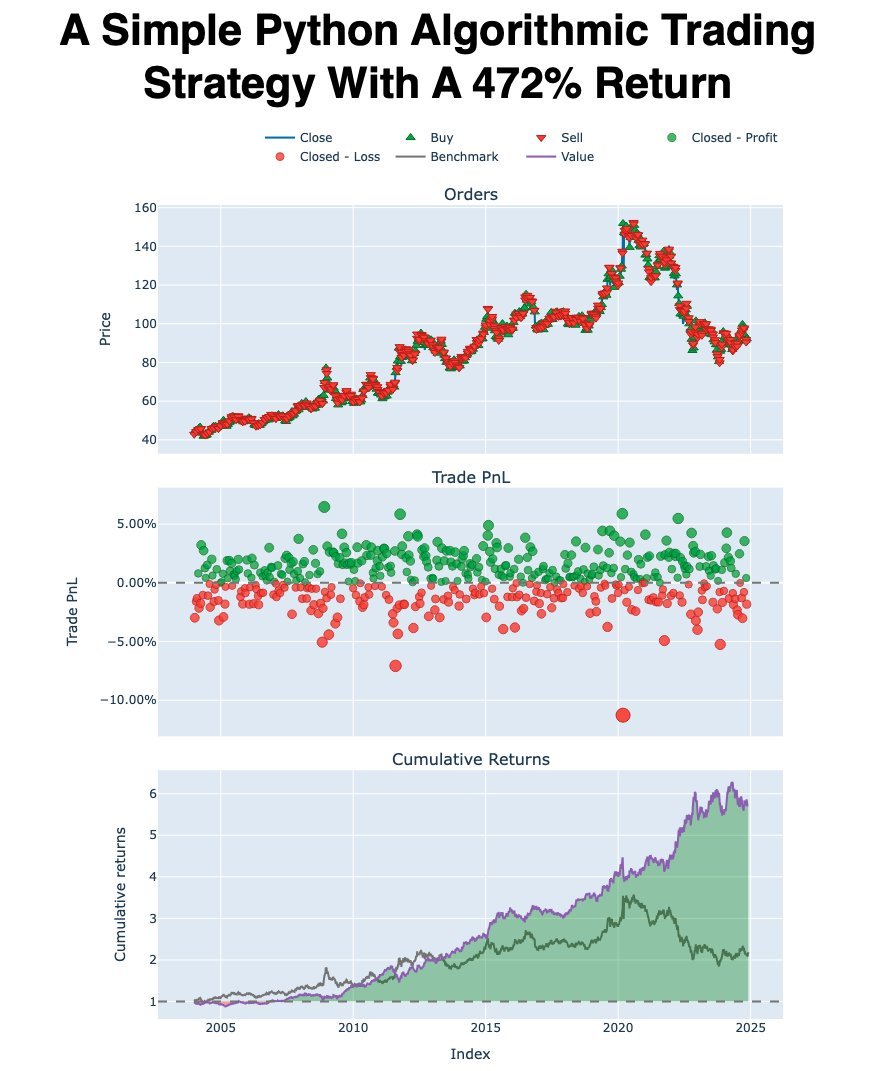Algorithmic (“algo”) trading uses computer-driven rules to automate buys & sells (and take human emotion out of trading).
Below are 7 tested strategies on $SPY (S&P 500) & more—plus final pros/cons.
Not financial advice!
Below are 7 tested strategies on $SPY (S&P 500) & more—plus final pros/cons.
Not financial advice!
1) Scaling In (Averaging Down)
• Buy in portions as price drops
• E.g., allocate 50% at first RSI drop, another 50% if RSI falls an additional 5 pts
• Benefits: Lowers drawdowns, reduces time in market
• Best for mean-reverting assets
• Buy in portions as price drops
• E.g., allocate 50% at first RSI drop, another 50% if RSI falls an additional 5 pts
• Benefits: Lowers drawdowns, reduces time in market
• Best for mean-reverting assets
2) Sell the Rip
• Original RSI exit ⇒ large drawdowns
• “Q’s exit” rule: Sell if close > previous day’s high
• Outcome: Smoother equity curve, minimized prolonged dips
• Focus on timely exits vs. strict RSI signals
• Original RSI exit ⇒ large drawdowns
• “Q’s exit” rule: Sell if close > previous day’s high
• Outcome: Smoother equity curve, minimized prolonged dips
• Focus on timely exits vs. strict RSI signals
3) 1st Trading Day Strategy
• Buy at close on last trading day of the month, sell at close on the 1st trading day of next month
• Historically outperforms random day returns
• Variation: “Turn-of-the-month” (last 5 days + first 3 days) captures most market gains
• Buy at close on last trading day of the month, sell at close on the 1st trading day of next month
• Historically outperforms random day returns
• Variation: “Turn-of-the-month” (last 5 days + first 3 days) captures most market gains
4) 200-Day MA Pullback
• Trade only if $SPY > 200-day moving average (bullish filter)
• Buy on short-term price weakness (pullbacks)
• Typically invested ~30% of the time
• Less exposure vs. buy-and-hold, but still captures upside
• Trade only if $SPY > 200-day moving average (bullish filter)
• Buy on short-term price weakness (pullbacks)
• Typically invested ~30% of the time
• Less exposure vs. buy-and-hold, but still captures upside
5) Fabian Timing Model
• Weekly check: $SPX, $DJIA, & Utilities vs. 39-week MA
• If all 3 > 39-week MA ⇒ stay long $SPY
• If ≥ 2 < 39-week MA ⇒ exit
• Historically outperforms buy-and-hold with ~50% market exposure
• Weekly check: $SPX, $DJIA, & Utilities vs. 39-week MA
• If all 3 > 39-week MA ⇒ stay long $SPY
• If ≥ 2 < 39-week MA ⇒ exit
• Historically outperforms buy-and-hold with ~50% market exposure
6) Meb Faber Momentum
• Assets: $SPY (stocks), $TLT (bonds), $GLD (gold)
• If 3-month MA > 10-month MA ⇒ invest; else ⇒ stay out
• Historically ~13% annual returns w/ lower drawdowns
• Performance dipped post-2015 but still a classic momentum model
• Assets: $SPY (stocks), $TLT (bonds), $GLD (gold)
• If 3-month MA > 10-month MA ⇒ invest; else ⇒ stay out
• Historically ~13% annual returns w/ lower drawdowns
• Performance dipped post-2015 but still a classic momentum model
7) Simple Mean Reversion
• Just 1 buy variable + 1 sell variable (S&P 500)
• ~15% annual return since ’93, only ~35% time in market
• Sharply lower drawdowns vs. buy-and-hold
• Shows power of straightforward rule sets
• Just 1 buy variable + 1 sell variable (S&P 500)
• ~15% annual return since ’93, only ~35% time in market
• Sharply lower drawdowns vs. buy-and-hold
• Shows power of straightforward rule sets
Conclusions:
• AlgoTrading can be simple yet effective
• Key: rigorous backtesting, clear rules, consistent execution
• Pros: Automation, scalability, fewer emotional errors
• Cons: Coding learning curve
• Keep it systematic & disciplined!
You can do this!
• AlgoTrading can be simple yet effective
• Key: rigorous backtesting, clear rules, consistent execution
• Pros: Automation, scalability, fewer emotional errors
• Cons: Coding learning curve
• Keep it systematic & disciplined!
You can do this!
Want to learn how to get started with algorithmic trading with Python?
Then join us on February 12th for a live webinar, how to Build Algorithmic Trading Strategies (that actually get results)
Register here (500+ registered): learn.quantscience.io/qs-register
Then join us on February 12th for a live webinar, how to Build Algorithmic Trading Strategies (that actually get results)
Register here (500+ registered): learn.quantscience.io/qs-register

• • •
Missing some Tweet in this thread? You can try to
force a refresh


















